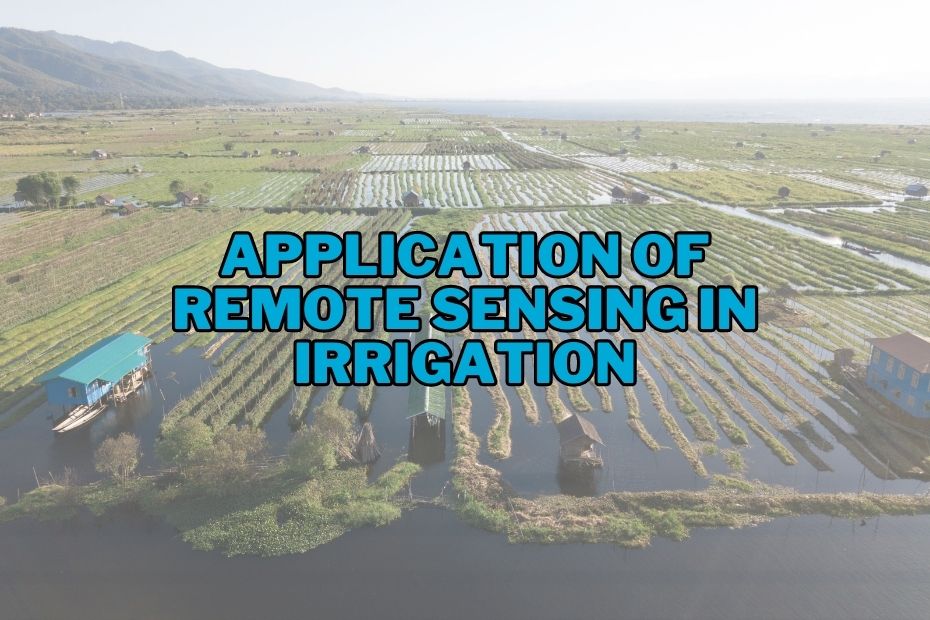Agriculture is rapidly embracing technology, and one of the standout advancements is the application of remote sensing in irrigation. The combination of sophisticated monitoring and data-driven insights leads to more efficient farming practices. In this article, goal is to highlight the immense potential that lies in integrating remote sensing with irrigation management.
The application of remote sensing in irrigation involves the use of satellite or aerial imagery to monitor soil moisture and crop conditions. This technology enables precise irrigation management, conserving water by applying it only where and when needed, and enhances crop yields by providing timely and targeted watering.
The 15 Application of Remote Sensing In Irrigation: A Transformative Approach
In a world where water scarcity is an ever-present challenge and agriculture consumes nearly 70% of the planet’s freshwater supply, the management of irrigation is not just about nourishment but survival. Imagine a future where farmers can gauge the thirst of their crops from miles away, directing water with pinpoint accuracy to where it’s needed most.
Join us as we explore how this cutting-edge technology is revolutionizing the way we grow our food, conserve our most precious resource, and contribute to a sustainable future
1. Monitoring Soil Moisture Levels
Understanding soil moisture levels is crucial in irrigation as it directly impacts crop health and yield. Remote sensing provides an efficient way to monitor soil moisture levels at a large scale, using specific algorithms to interpret data collected by satellite sensors. This technology aids farmers in decision-making, helping them to apply appropriate amounts of water at the right times, thereby optimizing irrigation and improving productivity.
2. Crop Health Monitoring
Remote sensing is increasingly used for crop health monitoring, allowing early detection of diseases and pests. Through differentiating healthy plants from stressed ones based on their spectral reflectance, farmers can take prompt corrective measures. This targeted approach minimizes the loss of yield and enhances the overall health of the crop.
3. Climate Analysis
Accurate climate analysis is essential for successful farming. Remote sensing technologies provide detailed data about weather patterns and seasonal shifts, facilitating better planning and adaptation strategies in farming and irrigation practices. Explore how remote sensing aids in climate analysis.
4. Yield Prediction and Analysis
With remote sensing, farmers can predict crop yield well in advance. By correlating historical yield data with current remote sensing data, predictive models are created that accurately forecast the yield. This aids farmers in planning the harvest and post-harvest activities efficiently.
5. Flood Management
One significant application of remote sensing in irrigation is flood management. Satellites can detect potential flood risks by identifying heavy rainfall areas and high river levels. This information enables farmers to take preventive measures, thereby minimizing damage to crops and infrastructure.
6. Drought Management
Just as it aids in flood management, remote sensing also helps in drought management by monitoring precipitation levels and soil moisture. This data assists farmers in implementing water-saving irrigation techniques during dry periods, reducing the impact of droughts on crop yield.
7. Groundwater Management
Groundwater plays a vital role in irrigation, and its judicious use is essential for sustainable farming. Remote sensing technology provides valuable insights into groundwater availability and helps in mapping groundwater potential zones, ensuring sustainable usage and management of this crucial resource.
8. Real-time Monitoring and Control
Remote sensing offers real-time monitoring and control of irrigation systems, ensuring optimal water usage. Farmers can remotely control the irrigation schedule based on real-time data, saving both water and time.
9. Customized Farming Practices
By providing detailed information about soil quality, weather patterns, and crop health, remote sensing allows farmers to customize their farming practices. This data-driven approach results in efficient irrigation, optimal fertilizer usage, and ultimately, higher crop yields.
10. Satellite Imagery for Large Scale Analysis
Large scale agricultural practices greatly benefit from satellite imagery. Detailed satellite images can reveal patterns, trends, and changes in agricultural fields over time, offering valuable insights for improving irrigation practices.
11. Water Quality Assessment
Water quality is a crucial factor in irrigation. Remote sensing technologies, through their spectral analysis capabilities, can assess the quality of irrigation water, identifying harmful substances and pollutants that might affect crop health.
12. Integration with IoT Devices
Remote sensing can be seamlessly integrated with Internet of Things (IoT) devices to create smart irrigation systems. These systems collect and analyze data in real-time, automatically adjusting irrigation schedules and volumes to meet the exact needs of the crops.
13. Disaster Mitigation
Remote sensing aids in disaster mitigation by predicting adverse weather conditions and potential risks to agricultural practices. This technology can be instrumental in devising strategies to reduce the impact of natural disasters on irrigation and farming.
14. Environmental Sustainability
By optimizing water usage and contributing to effective resource management, remote sensing promotes environmental sustainability. It helps to minimize the environmental footprint of agricultural activities and encourages the adoption of sustainable farming practices.
15. Remote Training and Support
Remote sensing also facilitates remote training and support, allowing farmers to learn about advanced irrigation practices and receive expert assistance without geographical constraints. This contributes to the widespread adoption of innovative farming methods, leading to more efficient and productive agricultural practices.
Conclusion:
The application of remote sensing in irrigation has indeed ushered in a new era of precision, efficiency, and sustainability. By leveraging the latest technologies, we can conserve resources, maximize yields, and foster an environment that is conducive to both growth and preservation.
FAQs: Application of Remote Sensing In Irrigation
How Does Remote Sensing Help in Monitoring Soil Moisture?
It uses satellite imagery to accurately track the moisture content of the soil, allowing for targeted irrigation.
Can Remote Sensing Predict Floods and Droughts?
Yes, it can predict and manage both floods and droughts by analyzing weather patterns and water levels.
How Can Remote Sensing be Integrated with IoT Devices?
Through advanced technologies, remote sensing can be integrated with IoT devices to automate and control irrigation systems in real time.
